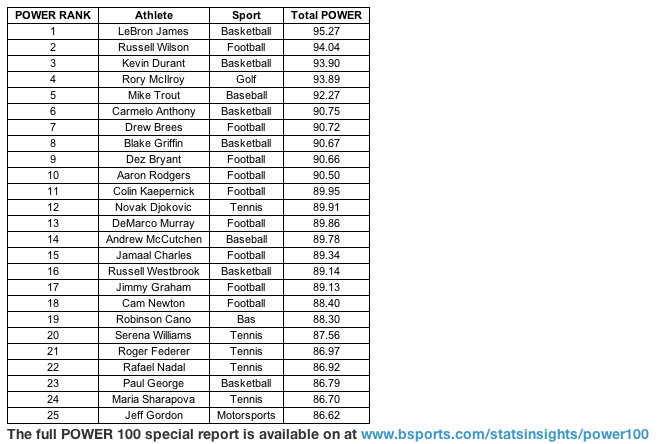The Cleveland Cavaliers LeBron James (No. 1), Seattle Seahawks Russell Wilson (No. 2), and Oklahoma City Thunder’s Kevin Durant (No. 3) top the Horrow Sports Ventures/MVPindex 2014 POWER 100 ranking of the world’s most powerful pro athletes in the U.S.
To determine who the 100 most powerful athletes are on- and off-the-field as the leaves begin to change and summer sports transition over to fall, Rick Horrow, CEO of Horrow Sports Ventures, collaborated with Dallas, TX based MVPindex, with an assist from Bloomberg Sports, the world’s leader in sports analytic technology.
For 2014, on-field attributes comprise 50% of the athletes POWER. The other 50% is based entirely on a key off-field attribute: social media presence. Combining on-field (50%) and off-field (50%) attributes yields the POWER score. Athletes are then ranked based on POWER to find the top 100.

“This is the fifth year of the Power 100, and it continues to command attention as an invaluable tool to evaluate an athlete’s brand and marketability,” said Horrow. “By focusing narrowly on social media for our off-field component, we are combining strong performance analytics with the most robust social media statistics in the industry, forming a new way of analyzing an athlete’s overall performance measurement.”
In its fifth consecutive installment, The POWER 100 uses a complex statistical model to accurately compare performance and influence through on-field and off-field attributes. This metric is collectively known as POWER, and enables equitable comparison across otherwise incomparable sports.
The 2014 POWER 100 focuses on long-established sports and the U.S. market specifically. Key indicator statistics were used as predictors of performance per sport, and statistical weight varied with impact. For sports lacking indicator statistics, such as tennis and golf, relevant rankings were used.
Boxing, MMA, and soccer are not included in the 2014 POWER 100 rankings, a change from earlier iterations of the rankings.
ON-FIELD SPECIFICATIONS
The on-field attributes measure an athlete’s ranking within his or her sport, relative to all other participants. Each athlete is compared to peer group averages, by sport (and position when necessary), in a number of statistical categories.
Next, a multiplier is used to adjust athletes rankings, based on the popularity and viewing audience of that sport. Given that some sports schedules overlap the calendar year, data for the 2014 POWER 100 is sourced from that sport’s most recently-completed regular season, or, in the case of tennis and golf, through the conclusion of the sports “majors” (and including Ryder Cup data in golf’s calculations). NFL statistics, finally, were based on the entire 2013-2014 season as well as numbers through the 2014 Week Four. The 2014 POWER 100 allows inclusion of the full 2013-2014 NBA and NHL seasons.
OFF-FIELD SPECIFICATIONS
The off-field score was measured by the MVPindex, a unique scoring algorithm that blends three key social media metrics in its calculation. Unlike other indices that principally measure Reach-the size of one’s potential audience-MVPindex considers Reach along with the subject’s actual social media engagement activity and the conversation surrounding the athlete across the web.
These three components-Reach, Engagement, and Conversation-provide a much more focused picture of an athlete’s influence and the overall value of his or her social media footprint.
Unlike prior years, in which the NFL dominated the top quarter of the list, the 2014 Power 100 reveals a more homogenous balance between athletes participating in individual sports and team sports. Baseball players came in strong as the MLB regular season ended and interest in the post season built. Tennis players continued to show their marketplace mettle, led by Serena Williams (No. 20, the top-ranked woman on the list), Maria Sharapova (No. 24), and World Number One Novak Djokovic (No. 12).
“MVPindex measures what people really care about, not what they ‘say they care about,” said co-founder and CMO Kyle Nelson. “Traditionally, sports marketers have relied on survey-based tools to gather intelligence on athletes. MVPindex both captures and measures conversations in real-time across the Socialsphere to evaluate an athletes sponsorship value. People are spending more time in social media than watching TV, reading magazines or listening to the radio. So, it just makes sense that a new measurement model is introduced.”














